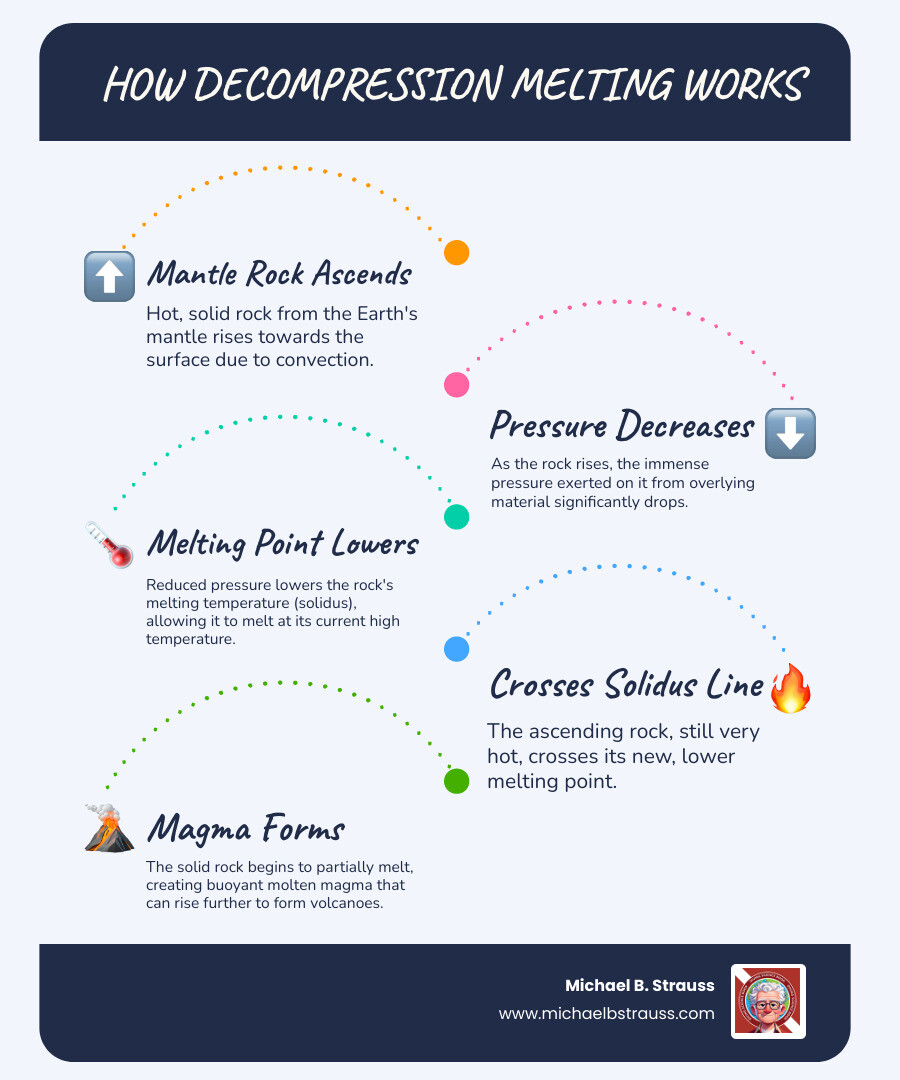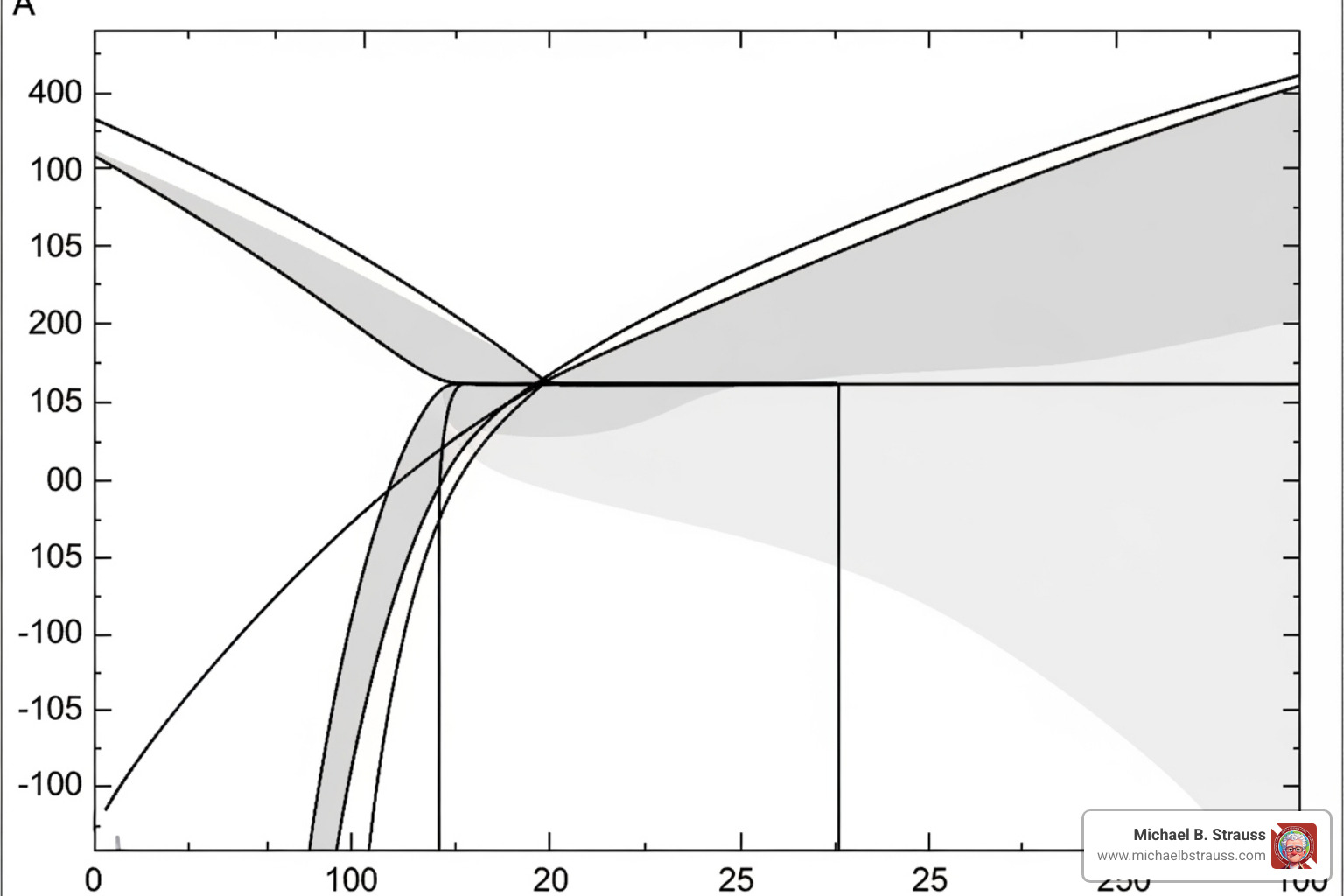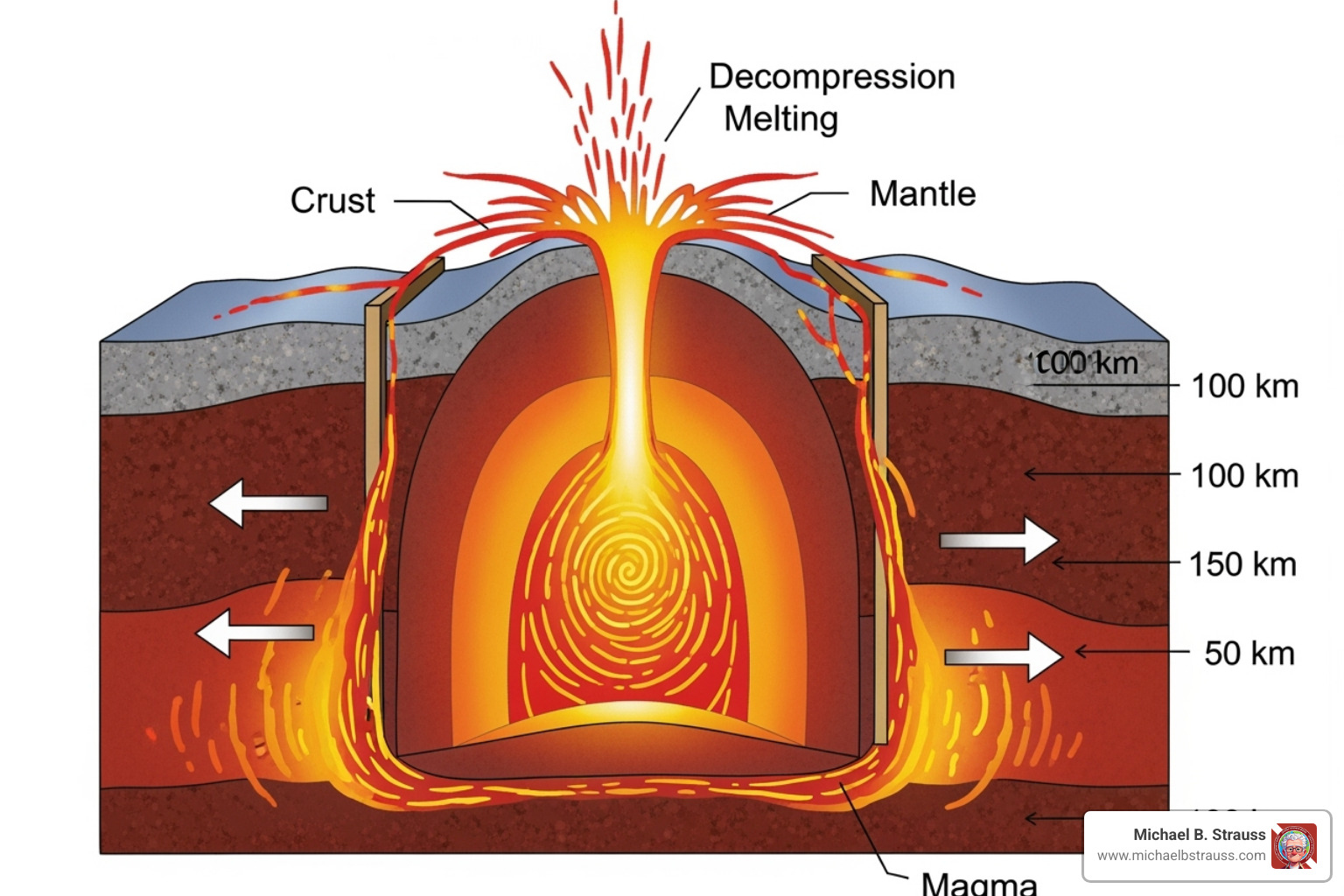What is Decompression Melting?
The decompression melting definition science describes a fundamental geological process. It's how solid rock deep within the Earth turns into molten magma.
Here’s a quick breakdown:
- What it is: The melting of solid rock (usually mantle material) due to a decrease in pressure.
- How it happens: As hot rock moves upwards towards the Earth's surface, the pressure on it drops significantly. Even without a temperature increase, this pressure drop lowers the rock's melting point.
- Result: The rock crosses a critical threshold (its solidus line) and begins to melt, forming magma.
Deep beneath our feet, the Earth is constantly in motion. This dynamic activity drives incredible geological processes. One of the most important is decompression melting. It's responsible for creating vast amounts of magma that feed volcanoes and build new crust. This process is key to understanding how our planet works, from the ocean floor to powerful volcanic eruptions.

Decompression melting definition science terms to learn:
The Decompression Melting Definition Science: How and Where It Happens
Understanding decompression melting definition science requires us to dive into some fascinating physics happening deep beneath our feet. It's not what most people imagine when they think about melting rock. You might picture a blazing hot furnace heating up a stone until it glows and turns to liquid. But here's the surprising part – most rock melting inside Earth happens without adding any extra heat at all!
The Core Science: Understanding Pressure, Temperature, and the Solidus
Think about boiling water on a mountain peak versus at sea level. Up high, where the air pressure is lower, water boils at a much cooler temperature. The same principle works with rocks deep in the Earth, just in reverse. When pressure increases, rocks need to get even hotter before they'll melt.
Deep in Earth's mantle – that thick layer of rock beneath the crust – temperatures can reach over 1300°C. That's hot enough to melt copper! Yet most of this rock stays completely solid. Why? Because the immense weight of all the rock above creates crushing pressure that keeps everything locked in solid form.
Scientists use something called the solidus line to understand when melting begins. Picture it as an invisible boundary on a graph. On one side, rock stays solid. Cross that line, and melting starts. There's also a liquidus line where rock becomes completely liquid. Between these two lines sits a mushy zone of partial melting – some liquid, some solid, like a geological slushie.

Now here's where decompression melting gets interesting. When hot mantle rock rises toward the surface quickly, something remarkable happens. The rock doesn't have time to cool down much, but the pressure on it drops dramatically. It's like taking the lid off a pressure cooker – suddenly the conditions change completely.
As this hot rock ascends and pressure decreases, its melting point drops too. Even though the rock's temperature stays roughly the same, it eventually crosses that solidus line we talked about. Boom – melting begins! Scientists call this adiabatic melting because the rock doesn't gain or lose heat during the process.
Research shows this magical change typically starts around 125 kilometers deep, where Earth's natural temperature comes closest to crossing the solidus line. Usually only about 10% of the rock melts, but sometimes up to 40% can turn liquid, creating the basaltic magma we see erupting from volcanoes.
This process works completely differently from other types of rock melting:
| Melting Type | How It Works | Where It Happens | What It Creates |
|---|---|---|---|
| Decompression Melting | Pressure drops, lowering melting point | Mid-ocean ridges, hot spots, rift zones | Basaltic magma (low silica) |
| Flux Melting | Water or gases added, lowering melting point | Subduction zones | Andesitic to explosive magmas |
| Heat-Induced Melting | Direct heating above melting point | Rare, very hot plumes | Variable compositions |
Decompression melting stands out because it's simply about releasing pressure – like uncorking a bottle and watching the contents respond to the change.
Key Geological Settings for Magma Formation
Decompression melting definition science comes alive in three main geological theaters around our planet. Each setting creates its own dramatic show of volcanic activity.
Mid-ocean ridges provide the most spectacular example. Picture the seafloor slowly pulling apart like a giant zipper opening. As oceanic plates separate, hot mantle rock rises up to fill the gap. This upward journey causes massive pressure drops, triggering extensive decompression melting. The resulting basaltic magma erupts continuously, building brand new ocean floor. This process, called seafloor spreading, literally creates new Earth surface every day.
Mantle plumes create some of our planet's most famous volcanic landmarks. Imagine a narrow column of superheated rock rising like a geological elevator from deep in the mantle – possibly from 2,880 kilometers down near the core! As this material ascends, pressure drops cause decompression melting far from any plate boundaries. This creates volcanic "hot spots" like Hawaii's shield volcanoes or Yellowstone's massive caldera.
Iceland sits in a particularly exciting spot – right on top of both a mid-ocean ridge and a mantle plume. This double dose of decompression melting makes it one of the most volcanically active places on Earth. Scientists have used seismic waves to map the plume extending at least 400 kilometers deep beneath the island.
Continental rift zones show us continents in the process of breaking apart. The East African Rift Valley provides a perfect example. As continental crust stretches and thins, underlying mantle rock rises to shallower depths. This upward movement reduces pressure and triggers decompression melting, often creating extensive basaltic volcanism. If rifting continues long enough, these zones can eventually become new ocean basins.
You can explore more about these melting processes in this scientific diagram of melting triggers, and find additional insights through more info about diving science.

What Types of Rock Does Decompression Melting Create?
When decompression melting works its magic on mantle rock, it almost always produces basaltic magma. This happens because Earth's mantle consists mainly of peridotite – a rock packed with iron and magnesium but relatively low in silica content.
During partial melting, only certain minerals melt first – typically those with lower melting points. This creates a melt that's more silica-rich than the original rock but still qualifies as basaltic. The resulting magma flows easily, usually creating gentle, effusive eruptions rather than explosive ones.
When this basaltic magma cools and hardens, it forms dark-colored igneous rocks rich in minerals like pyroxene and olivine. These rocks build most of our planet's oceanic crust – every square meter of ocean floor started as magma from decompression melting at mid-ocean ridges.
Beyond the seafloor, this process creates the volcanic islands we see at hot spots, the massive lava flows in continental rift zones, and the shield volcanoes that form geological landmarks. Each represents decompression melting in action, constantly reshaping our planet's surface through this fundamental geological process.
The mineral composition of these rocks tells the story of their deep origins, carrying chemical signatures from the mantle up to Earth's surface where we can study them and understand our planet's inner workings.
Geological Impact and a Critical Distinction for Divers
Okay, let's talk about something super cool: decompression melting definition science! While it sounds like a mouthful, understanding this powerful geological process isn't just for scientists in labs. It helps us truly appreciate the dynamic nature of our Earth, and it even offers some fascinating parallels to another world we love to explore: the underwater field of diving.
Why Decompression Melting is a Crucial Planetary Process
Why is decompression melting such a big deal for our planet? Well, it's nothing short of foundational!
First off, it's the primary way our Earth builds its skin. Think about Crust Formation and Chemical Differentiation. At mid-ocean ridges, as those tectonic plates pull apart, new oceanic crust is constantly being born thanks to magma formed by decompression melting. This isn't just about adding new land; it's also about the Earth's very chemistry changing over time. When mantle rock partially melts, it pulls out specific elements, leading to a natural chemical differentiation that helps create both the oceanic and continental crust we know.
Beyond building new land, decompression melting powers a huge chunk of the world's Volcanic Activity. It's behind those vast, non-explosive lava flows you see at mid-ocean ridges and famous hot spots like Hawaii. These eruptions are like Earth's pressure valves, releasing heat and gases from deep inside, which even influences our planet's atmosphere and climate.
This process is also a key player in Earth's grand system of Heat Transfer. It’s part of the slow, churning movement of the Earth's mantle, known as mantle convection, which drives plate tectonics. The upward flow of hot mantle material, which then melts, is a vital way our planet moves heat from its scorching core to the surface.
And guess what? This deep-Earth activity is constantly Shaping Landscapes. From the colossal Mid-Atlantic Ridge, the longest mountain range on Earth, to iconic volcanic islands and dramatic continental rift valleys, the forces releaseed by decompression melting sculpt our world.
Surprisingly, it’s even connected to some valuable treasures! Ore deposits like chromite, nickel-copper sulfides, platinum group elements (PGEs), and even diamond deposits found in kimberlites are linked to the magma generation and movement that stems from decompression melting.
So, decompression melting is truly a cornerstone for understanding plate tectonics, volcanism, and the very makeup of Earth's crust. It’s a powerful reminder of the unseen forces beneath our feet! For another fascinating look at how pressure changes affect us, consider Why decompression sickness can occur in divers.
A Critical Distinction: Geological vs. Physiological Decompression
Now, here's where things get interesting, especially if you're a diver! The word "decompression" is used in both geology and diving, but they mean vastly different things. It’s a common term that points to two very different scientific scenarios, so let's make sure we don't mix them up!
When geologists talk about decompression melting, they're describing a process where solid rock deep inside Earth transforms into liquid magma. This happens because the pressure on that hot rock drops, lowering its melting point. So, it's about a change in the physical state of the rock itself.
But for divers, "decompression" typically brings up thoughts of decompression sickness (DCS), often called "the bends." In this case, decompression refers to the reduction in ambient pressure as a diver ascends from depth. This pressure decrease causes dissolved gases (primarily nitrogen) that have accumulated in the diver's body tissues under higher pressure to come out of solution and form bubbles. This process is governed by a principle called Henry's Law.
So, the core difference is what's changing. In geology, it's the rock itself melting. In diving, it's dissolved gases forming bubbles in your body. The mechanism is also distinct: geological decompression lowers a rock's melting point, allowing it to melt at its existing high temperature, while physiological decompression means gases become less soluble in your body's fluids. And the impact? Geological decompression builds continents and fuels volcanoes, while physiological decompression can cause pain, neurological symptoms, and in severe cases, be very dangerous for a diver if bubbles obstruct blood flow or damage tissues.

Just as geologists use their understanding of pressure-temperature relationships to predict where magma forms, divers must use their knowledge of pressure and dissolved gases to plan safe ascents and prevent DCS. It's all about respecting the laws of physics and chemistry! To dive deeper into how pressure affects the human body underwater, you can Learn more about decompression science.
Conclusion: Understanding Our Dynamic Planet
We've journeyed deep into the Earth's interior, explored the fascinating process of decompression melting definition science, and seen how it shapes our planet's crust, fuels its volcanoes, and even creates valuable resources. From the slow, steady upwelling of mantle rock beneath mid-ocean ridges to the dramatic plumes that create volcanic islands, decompression melting is a testament to the powerful, unseen forces that make Earth a dynamic and ever-changing world.
Understanding these geological processes not only satisfies our scientific curiosity but also highlights the universal nature of scientific principles. The way pressure affects melting points in rocks has a distant, yet equally critical, parallel in how pressure affects dissolved gases in a diver's body. Whether we're studying the Earth's fiery heart or the silent depths of the ocean, a solid grasp of scientific fundamentals is our best tool for comprehension and, ultimately, for safety.
To truly master the scientific principles that keep you safe underwater, get your copy of Diving Science Revisited today.
DISCLAIMER: Articles are for "EDUCATIONAL PURPOSES ONLY", not to be considered advice or recommendations.






